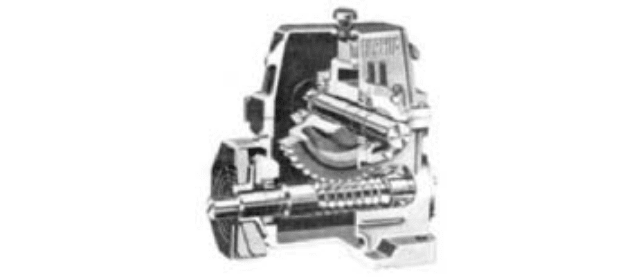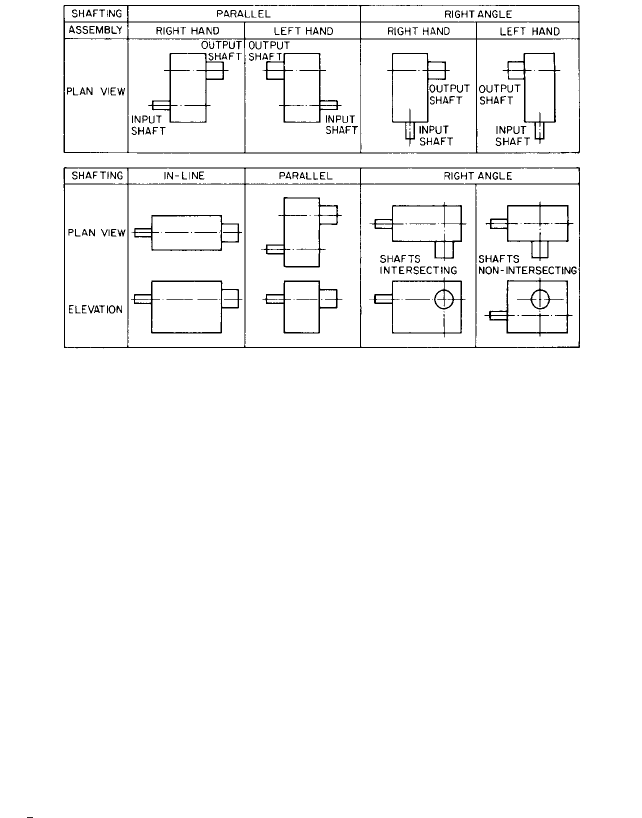Pump Handbook by Igor J. Karassik, Joseph P. Messina, Paul Cooper, Charles C. Heald - 3rd edition
Подождите немного. Документ загружается.

6.2.4 GEARS 6.147
these gears, they are often known as “the gears with a backbone.” Continuous-tooth her-
ringbone gears are used for the transmission of heavy loads at moderate speeds where
continuous service is required, where shock and vibration are present, or where a high
reduction ratio is necessary in a single train. Because of the absence of a groove between
opposing teeth, a herringbone gear has greater active face width than the hobbed double
helical gear and therefore is stronger. There is also no end thrust, as the opposing helices
counterbalance one another. The bearing arrangement of herringbone gears is usually the
same as double helix in that the pinion does not usually have a thrust bearing. See trans-
mission of external forces under Section 6.3.1.
Much of the success of the continuous-tooth herringbone gear is due to the greater
number of teeth in contact and to the continuity of tooth action, which is an outgrowth of
the larger helix angle.These larger helix angles can be fully utilized without creating bear-
ing thrust loads. Continuous-tooth herringbone gears normally are furnished with a helix
angle of 30°. Herringbone gears are generally of a lower American Gear Manufacturers
Association (AGMA) quality level than hobbed or ground gears.
Crossed-Axis Gearing
STRAIGHT-BEVEL GEARS Gears of this type transmit power between two shafts usually at
right angles to each other. However, shafts other than 90° can be used. The speed ratio
between shafts can be decreased or increased by varying the number of teeth on pinion
and gear. These gears are designed to operate at speeds up to 1000 ft/min (300 m/min)
and are more economical than spiral-bevel gears for right-angle power transmission
where operating conditions do not warrant the superior characteristics of spiral-bevel
gearing. When shafts are at right angles and both shafts turn at the same speed, the two
bevel gears can be alike and are called miter gears.
SPIRAL-BEVEL GEARS
Spiral-bevel gear teeth and straight-bevel gear teeth are both cut on
cones. They differ in that the cutters for straight-bevel teeth travel in a straight line,
resulting in straight teeth, whereas the cutters for spiral-bevel gear teeth travel in the
arc of a circle, resulting in teeth that are curved and are called spiral. Figure 4 shows a
cross section of a spiral-bevel vertical pump drive.
Spiral-bevel gearing is superior to straight-bevel in that, in the former, loading is
always distributed over two or more teeth in any given instant. Recommended maximum
pitch line velocity for spiral bevels is about 8000 ft/min (2400 m/min). Spiral bevels are
also smoother and quieter in action because the teeth mesh gradually. Because of the
curved teeth, spiral-bevel pinions may be designed with fewer teeth than straight-bevel
pinions of comparable size. Thrust loads are greater for spiral-bevel gearing than for
straight-tooth bevels, however, and vary in axial direction with the direction of rotation
and hand of cut of the pinion and gear. Where possible, the hand of spiral should be
selected such that the pinion tends to move out of mesh. To assure that the pinion thrust
is away from the cone center, out of mesh, the following applies:
Driving Member Hand of Spiral Rotation Direction
Pinion Left Hand CW
Pinion Right Hand CCW
Gear Right Hand CCW
Gear Left Hand CW
Reversing the direction of rotation should be avoided.
ZEROL GEARS Zerol-bevel gears are cut on conical gear blanks and have curved teeth sim-
ilar to the spiral bevels, but the teeth are cut with a circular cutter that does not pass
through the cone apex. Thus, these are spiral-bevel gears with zero spiral angle (hence
the name). Furthermore, the tooth bearing is localized as in spiral-bevel gearing; thus
stress concentration at the tips of the gear teeth is eliminated. Zerol-bevel gears are
replacing straight-bevel gearing in many installations because their operation is

6.148 CHAPTER SIX
FIGURE 6 Fan-cooled worm gear drive
smoother and quieter as a result of their curvature and their operating life is longer. Like
straight-bevel gears, zerol gears have the advantage of no inward axial thrust under any
conditions. The zero spiral angle produces thrust loads equivalent to those in straight-
bevel gears.
HYPOID GEARS
Hypoid-bevel gears have the general appearance of spiral-bevel gears but
differ in that the shafts supporting the gears are not intersecting. The pinion shaft is off-
set to pass the gear shaft. The pinion and gear are cut on a hyperboloid of revolution, the
name being shortened to hypoid. Hypoid gears can be made to provide higher ratios than
spiral-bevel gears. They are also stronger and operate even more smoothly and quietly.
The fact that two supporting shafts can pass each other, with bearings mounted on oppo-
site sides of the gear, provides the ultimate rigidity in mounting.
WORM GEARS In operation, the teeth on the worm of a worm gear set (Figure 6) slide
against the gear teeth and at the same time produce a rolling action similar to that of a
rack against a spur constant output speed completely free of pulsations. Worm gearing is
particularly adaptable to service where heavy shock loading is encountered.
Worm gearing is extremely compact, considering load-carrying capacity. Much higher
reduction ratios can be attained through a worm gear set on a given center distance than
through any other type of gearing.Thus, the number of moving parts in a speed-reduction
set is reduced to the absolute minimum. However, worm gearing is limited in power capac-
ity and has lower efficiencies than parallel-shaft and bevel-gear types. Extremely high
worm thrust loads are generated by work gearing. Therefore, never reverse the rotation
unless the unit is specifically designed for operation in both directions.
GEAR MATERIALS AND HEAT TREATMENT ______________________________
Two of the most important factors in dictating the success or failure of a gear set are the
choice of material and heat treatment.This is especially true for gears designed for higher
power. American Gear Manufacturers Association (AGMA) ratings for gear strength and
durability are dependent on the choice of material and heat treatment. It is often possible
to reduce the size of the gear box substantially by simply changing from low-hardened or
medium-hardened gears (about 300 Brinell) to full-hardened gears (about 55 to 60 Rock-
well C). Generally used methods for hardening gear sets are
1. Through hardening
2. Nitriding
6.2.4 GEARS 6.149
3. Induction hardening
4. Carburizing and hardening
5. Flame hardening
The use of high-hardness, heat-treated steels permits smaller gears for given loads.
Also, hardening can increase service life up to 10 times without increasing size or weight.
After hardening, however, the gear must have at least the accuracy associated with softer
gears and, for maximum service life, even greater precision. Furthermore, carburized and
ground gears must be aligned within their housings to a higher degree of accuracy than
through-hardened gears. This is because their ability to “comply with” misalignment is
less, although they are capable of transmitting much higher loads and longer life when
properly aligned.
Through Hardening Suitable steels for medium to deep hardening are 4140 and 4340.
These steels, as well as other alloy steels with proper hardenability characteristics and
carbon content of 0.35 to 0.50, are suitable for gears requiring maximum wear resistance
and high load-carrying capacity. Relatively shallow-hardening carbon steel gear materi-
als, types 1040, 1050, 1137, and 1340, cannot be deep hardened and are suitable for gears
requiring only a moderate degree of strength and impact resistance.A 4140 steel will pro-
duce a hardness of 300 to 350 Brinell. For heavy sections and applications requiring
greater hardness, a 4340 steel will provide 350 to 400 Brinell. Cutting of gears in the 380
to 400 Brinell range, although practical, is generally difficult and slow.
Nitriding Nitriding is especially valuable when distortion must be held to a minimum.
It is done at a low temperature (975 to 1050°F, 524 to 566°C) and without quenching
—
eliminating the causes of distortion common to other methods of hardening and often nec-
essary for finish machining after hardening. Nitrided case depths are relatively shallow
so nitriding is generally restricted to finer pitch gears (four-diameter pitch or finer). How-
ever, double-nitriding procedures have been developed for nitriding gears with as coarse
as two diametral pitch.
Any of the steel alloys that contain nitride-forming elements, such as chromium, vana-
dium, or molybdenum, can be nitrided. Steels commonly nitrided are 4140, 4340, 6140, and
8740. It is possible with these steels to obtain core hardnesses of 300 to 340 Brinell and
case hardnesses of 47 to 52 Rockwell C. Where harder cases are required, one of the Nitral-
loy steels may be used. These steels develop a case hardness of 65 to 70 Rockwell C with a
core hardness of 300 to 340 Brinell. The depth of case in a 4140 or 4340 steel varies as the
length of time in the nitriding furnace. A single nitride cycle will produce a case depth of
0.025 to 0.030 in (0.64 to 0.76 mm) in 72 h. Doubling the time will produce a case depth of
0.045 to 0.050 in (1.14 to 1.27 mm). For the majority of applications, the case depth ob-
tained from a single cycle is ample.
Case depth for Nitralloy steels is somewhat less than the depths obtainable for other
alloy steels. In general, alloy steels 4140 and 4340 give up to 50% deeper case than Nitral-
loy steels for the same furnace time. These cases are tougher but less hard.
Induction Hardening Two basic types of induction hardening are used by gear manu-
facturers: coil and tooth-to-tooth. The coil method consists of rotating the work piece inside
a coil producing high-frequency electric current. The current causes the work piece to be
heated. It is then immediately quenched in oil or water to produce the desired surface
hardness. Hardnesses produced by this method range from 50 to 58 Rockwell C, depend-
ing on the material. The coil method hardens the entire tooth area to below the root.
Tooth-to-tooth full-contour induction hardening is an economical and effective method
for surface hardening larger spur, helical, and herringbone gearing. In this process, an
inductor passes along the contour of the tooth, producing a continuous hardened area from
one tooth flank around the root and up the adjacent flank. The extremely high localized
heat allows small sections to come to hardening temperature while the balance of the gear
dissipates heat. Thus major distortions are eliminated. The 4140 and 4340 alloy steels are
widely used for tooth-to-tooth induction hardening. The hardness of the case produced by
6.150 CHAPTER SIX
this method ranges from 50 to 58 Rockwell C, and the flanks may be hardened to a depth
of 0.160 in (4.06 mm). These steels are air-quenched in the hardening process. Plain car-
bon steels, such as 1040 and 1045, may be used for induction hardening, but they must be
water-quenched.
Carburizing Carburizing with subsequent surface hardening offers the best way to
obtain the very high hardness needed for optimum gear life. It also produces the
strongest gear, one that has excellent bending strength and high resistance to wear, pit-
ting, and fatigue. The residual compressive stresses inherent in the carburized case sub-
stantially improve the fatigue characteristics of this heat-treated material. Normal case
depths range from approximately 0.030 to 0.250 in (0.76 to 6.3 mm). Case hardnesses
range from 55 to 62 Rockwell C, and core hardness from 250 to 320 Brinell. Recom-
mended carburizing-grade steels are 4620, 4320, 3310, and 9310. The main limitation to
carburizing and hardening is that the process tends to distort the gear. Techniques have
been developed to minimize this distortion, but generally after carburizing and harden-
ing, it is necessary to grind or lap the gear to maintain the required tooth tolerances.
Flame Hardening In tooth-to-tooth progressive flame hardening, an oxyacetylene flame
is applied to the flanks of the gear teeth. After the surface has been heated to the proper
temperature, it is air- or water-quenched. This method has some limitations; because the
case does not extend into the root of the tooth, the durability is improved but the overall
strength of the gear is not necessarily. In fact, stresses built up at the junction of a hard-
ened soft material may actually weaken the tooth.
Many times it is desirable to use different heat treatments for the pinion and gears.
Heat-treatment combinations used for pinions and gears are here listed in order of pref-
erence for optimum gear design.
1. Carburized pinion, carburized gear
2. Carburized pinion, through-hardened gear
3. Carburized pinion/nitrided gear
4. Nitrided pinion/nitrided gear
5. Nitrided pinion/through-hardened gear
6. Induction-hardened pinion/through-hardened gear
7. Carburized pinion/induction-hardened gear
8. Induction-hardened pinion/induction-hardened gear
9. Through-hardened pinion/through-hardened gear
OPTIMIZING THE GEARING ____________________________________________
The most important factor influencing the durability of a gear set, and hence the gear size,
is the hardness of the gear teeth. It is often possible to reduce considerably
—
sometimes by
as much as half
—
the overall dimensions of a gear set by changing from medium-hardened
gears (about 300 Brinell) to full-hardened gears (about 55 to 60 Rockwell C).
Other factors play a role in minimizing the dimensions of a gear set; for example, the
ratio between face width and pitch diameter and the proper pressure angle and pitch of
teeth. Thus, when it comes to deciding between a set of standard catalog gears and gears
designed specifically to meet the requirements of the application, the question of cost ver-
sus optimizing comes to bear. In general, where there is only a limited number of units to
be made, the catalog gears are much less expensive and also much more readily available.
There are many applications that call for critical power, speed, or space requirements,

6.2.4 GEARS 6.151
however, and it may pay in these applications to select gears that are designed for that
application.
Minimizing Gear Noise Specifying or designing a gear set to produce low noise and
vibration levels frequently leads to choices that are the opposite of those for optimizing
the gears for strength and size. Generally, a parallel-shaft gearing rather than right-angle
gearing is preferred for quiet operation because of greater geometric control, inherent abil-
ity to maintain tight manufacturing tolerances, and minimum friction during tooth con-
tact. Helical gears, in particular, can have more than one tooth in contact (helical overlap),
and some experience has shown as much as a 12-dB reduction in noise using helical
instead of spur gears. Double helical or herringbone gearing has the problem of manu-
facturing the two helices with precisely the same phase and accuracy. Helical gearing
must have thrust bearings or collars on each element and so produce an overturning
moment. The overturning moment is more pronounced with single stage high ratio units
such as large diameter, narrow face-width gears, and small diameter pinions. These prob-
lems concerning double and single helical units are easily handled with proper design and
manufacturing.
For quiet, smooth operation, the gears should be designed with some or all of the fol-
lowing properties:
1. Select the finest pitch allowable under load considerations.
2. Employ the lowest pressure angle: 14 and 20° are most commonly used.
3. Modify the involute profile to include tip and root relief with a crowned flank to ensure
smooth sliding into and out of contact without knocking and to compensate for small
misalignments.
4. Allow adequate backlash (clearance) for thermal and centrifugal expansion, but not so
much as to prevent proper contact.
5. Specify the higher AGMA quality levels, which will reduce the total dynamic load.
Generally, AGMA quality 12 or better is required for smooth, quiet operation.
6. Maintain surface finishes of at least 20 microinches Ra (surface roughness average
value).
7. Maintain rotor alignments and runouts accurately.
8. Limit rotor unbalance per plane to less than
Umax 3 W/N in US units, and Umax 4760 W/N in SI units, where
Umax residual unbalance, oz in (g mm)
W static weight on the journal, lb (kg)
N maximum continuous speed, rpm
9. Provide a nonintegral ratio (“hunting tooth”) to prevent a tooth on the pinion from
periodically contacting the same teeth on the mating gear.
10. Have resonances of rotating system members (critical speeds) at least 30% away from
operating speed, multiples of rotating speeds, and tooth-mesh frequencies.
11. Have resonances of gear cases and other supporting members 20% away from oper-
ating speeds, multiples, and tooth-mesh frequencies.
12. Specify the highest-viscosity lubricant consistent with design and application.
13. Select rolling element bearings to minimize noise generation. Generally, hydrodynamic
sleeve bearings are quieter than antifriction types but are more difficult to apply.
14. Because housing design is another area where noise and vibration reductions can be
obtained, select an acoustically absorbent material for the housing or design the hous-
ing with built-in isolation mounts to cut down any vibration attenuation.
15. For parallel shaft gearing, it is recommended that speed increasers be up meshed and
speed reducers be down meshed to prevent rotor instability.
1
2
6.152 CHAPTER SIX
PACKAGED GEAR DRIVES ____________________________________________
In many cases, it is preferable to select a packaged gear drive rather than a set of open
gears that must be mounted and housed.
The relative merits of a packaged drive, or “gear reducer,” versus open gearing are
many. The packaged drive consists essentially of gears, housing, bearings, shafts, oil seals,
and a positive means of lubrication. Frequently, reducers also include any or all of the fol-
lowing: electric motor and accessories, bedplates or motor supports, outboard bearings, a
mechanical or electric device providing overload protection, a means of preventing reverse
rotation, and other special features as specified.
The advantages of packaged gear drives have been well established and should be
given consideration when selecting the type of gear drive for the application:
1. Power conservation. Because of accurate gear design, quality construction, proper
bearings, and adequate lubrication, minimum loss between applied and delivered
power is assured.
2. Low maintenance. If the correct design and power capacity for the requirements are
selected and the recommended operating instructions are followed, low maintenance
costs will result.
3. Operating safety. All gears, bearings, and shafts are enclosed in oil-tight, strongly built
cast iron or steel housings.
4. Low noise and vibration level. Precision gearing is carefully balanced and mounted on
accurate bearings. The transmitting motion is uniform and shock-free. The entire
mechanism is tightly sealed in sound-damping rigid housing. Noise and vibration are
reduced to a minimum.
5. Space conservation. Units are entirely self-contained and extremely compact; there-
fore, they require a small space. This also enables them to be installed in out-of-the-
way locations.
6. Adverse operating conditions. Enclosure designs have been developed to protect the
mechanism from dirt, dust, soot, abrasive substances, moisture, or acid fumes.
7. Economy. Units permit the use of high-speed prime movers directly connected to low
applied speeds.
8. Life expectancy. The life of a unit can be predetermined by design and made unlimited
if it is correctly aligned and properly maintained.
9. Power and ratios. Units are available in almost all desired ratios and for all practical
power requirements.
10. Cooling systems. Greater attention to sump capacity for oil and the use of fan air cool-
ing have allowed higher powers to be transmitted through smaller units without
overheating.
11. Appearance. Housings have been streamlined for eye appeal as well as for reduction
of weight and space.
12. Rugged capabilities. The ruggedness of steel-constructed welded housings and modern
housings produces higher reliability and service life.
Types of Gear Packages Gear packages are used in multiple combinations to produce
the ratio desired in the unit. Units are available in single-, double-, and triple-reduction
configurations. Three stages of reduction are generally the maximum number used in
standard reducers, although it is possible to use four or even more stages. Units for
increasing the output speed generally have only one gear set, although at times two-stage
units have been used successfully as speed increasers. Gear packages may be assembled
with shaft arrangements that are right-handed or left-handed (Figure 7).
ALLOWABLE SPEEDS OF GEAR REDUCERS The maximum speed of a gear reducer is limited by
the accuracy of the machined gear teeth, the balance of the rotating parts, the allowable

6.2.4 GEARS 6.153
FIGURE 7 Shaft arrangements for gear drives
noise and vibration, the allowable maximum speed of the bearings, the pumping and churn-
ing of the lubricating oil, the friction of the oil seals, and the heat generated in the unit.
At high speeds, it is possible for inaccuracies in the gear teeth to produce failure even
though no power is being transmitted. Gear reducers built in accordance with AGMA spec-
ifications are recommended to operate at speeds given in Table 1.
POWER RANGE OF GEAR REDUCERS
The power-transmitting capacity of a reduction gear unit
is a function of the output torque and the speed of the reducers. Some types of reducers,
such as worm gear reducers, are more satisfactory for high torques and low speeds,
whereas others, such as helical herringbone (or double helical), are suitable for high
torques and also high speeds. Therefore the range of powers suitable for various units is
considerable. A listing of this range obtainable in standard types of reducers is given in
Table 1, with a brief explanation of why the range indicated is maintained. These powers
are not fixed at the values given because they are continually changing.Although the val-
ues given are general, there are many special reducers available outside this range.
RATIOS AND EFFICIENCIES The ratio of a gear reducer is defined as the ratio of the input
shaft speed to the output shaft speed. Different types of gearing allow different ratios per
gear stage. Spur gears usually are used with a ratio range of 1:1 to 6:1; helical, double
helical, and herringbone with ratios of 1:1 to 10:1; straight-bevel with ratios of 1:1 to 4:1;
spiral-bevel (also zerols and hypoids) with ratios of 1:1 to 9:1; and worm gears with ratios
of 3 :1 to 90:1. Planetary gear arrangements allow ratios of 4:1 to 10:1 per gear stage.
Factors influencing the efficiency of a gear reducer are
1. Frictional loss in bearings
2. Losses due to pumping lubricating oil
3. Windage losses due to rotation of reducer parts
4. Frictional losses in gear tooth action
It is not uncommon in many types of reducers to have the combined losses due to items
1, 2, and 3 greater than the loss due to item 4. For this reason, in some cases the power lost
in the reducer remains practically constant regardless of the power transmitted. There-
fore, it must be realized that the efficiency specified for a reducer applies only when the
1
4

6.154
TABLE 1 Guide for gear selection and design (reflecting generally accepted design criteria)
Spur gearing Helical gearing
External Internal External Internal
Shaft arrangement Parallel axis Parallel axis Parallel axis Parallel axis
Ratio range 1:1 to 10:1 1 :1 to 10:1 1:1 to 15:1 2:1 to 15:1 (generally
feasible) Ratio depends
on pinion gear tooth
combination because of
clearance requirements
Size availability Up to 150-in (381-cm) OD, Up to 100-in (254-cm) OD, Up to 150-in (381-cm) OD, Up to 100 in (254 cm),
(including maximum 30-in (76.2-cm) face width. 16-in (406-cm) face width 30-in (76.2-cm) face width depending on blank
face widths) Larger segmental gears configuration; 16-in
can be produced with (406-cm) maximum
special processing and face width
tooling
Gear tolerances See footnote. See footnote. See footnote. See footnote.
(quality requirements)
Finishing methods Cast: rotary cut, shaped; Same as external spurs Shaped, bobbed, shaved, Shaped, bobbed, shaved,
(singly or in hobbed: shaved, ground ground honed, lapped, ground
combination)
Power range, hp (kW) Commercial: less than Commercial: generally up Same as external helical
1000 (750) to 50,000 (37,000) gearing
However, power limited
only by maximum size
capacity of design
Speed range, pitch Commercial: normal up to Commercial, standard To 30,000 (9100)
line velocity 1000 (300); special manufacture: up to 1000
precision up to 20,000 (300); precision manu-
(6100) facture: up to 20,000 (6100)
1
2

6.155
TABLE 1 Continued.
Spur gearing Helical gearing
External Internal External Internal
Gear efficiency, % Commercial: 95 to 98 97 to 99
Quietness of operation Commercial: quiet under 500 ft/min (150 m/min); Noise level depends on
noise increases with increasing pitch-line velocity quality of gear. Higher pitch
line velocity (above 5000 ft/
min (1500 m/min)) requires
higher precision gear.
Gears operating 30,000 ft/
min (9100 m/min) have
been made with overall
noise level below 90 dB.
Quieter than spur gears.
Load imposed Radial only Radial and thrust Radial and thrust
on bearings
External double helical gearing Continuous-tooth herringbone gearing
Shaft arrangement Parallel axis Parallel axis
Ratio range 1:1 to 15:1 1:1 to 10:1
Size availability Up to 150-in (381-cm) OD, 30-in (76.2-cm) face width Up to 150-in (381-cm) OD, 30-in (76.2-cm) face width
(including maximum
face widths)
Gear tolerances See footnote. See footnote.
(quality requirements)
Finishing methods Same as helical gearing Shaped, shaved
(singly or in
combination)

6.156
TABLE 1 Continued.
External double helical gearing Continuous-tooth herringbone gearing
Power range, hp (kW) Same as helical gearing Up to 2000 (1500)
Speed range pitch line Same as helical gearing Commercial: up to 5000 (1500)
velocity, ft/min (m/min)
Gear efficiency, % Same as helical gearing 96 to 98
Quietness of operation Same as helical gearing Quiet operation up to 5000 ft/min (1500 m/min). Not
generally used at extremely high pitch line velocity,
over 20,000 ft/min (6100 m/min).
Load imposed on Radial only Radial only
bearings
Straight-bevel gearing Spiral-bevel gearing Zerol-bevel gearing Hypoid gearing
Shaft arrangement Intersecting axis Intersecting axis Intersecting axis Nonintersecting,
nonparallel axis
Ratio range 1:1 to 6:1 1:1 to 10:1 1:1 to 10:1 1:1 to 10:1
Size availability Up to 102-in (55-cm) OD, Up to 102-in (55-cm) OD, 102-in (55-cm) OD, 12-in 102-in (55-cm) OD, 12-in
(including maximum 12-in (30.5-cm) face width 12-in (30.5-cm) face width (30.5-cm) face (30.5-cm) face
face widths)
Gear tolerances (quality See footnote. See footnote. See footnote.
requirements)
Finishing methods Cast, generated, planed Generated, planed, ground Generated, planed, ground Generated, planed,
(singly or in ground
combination)
Power range, hp (kW) Up to 1,500 (1120) Up to 20,000 (15,000), Same as straight bevel Same as spiral bevel
depending on speed gears gears, with use of EP
lubricants
